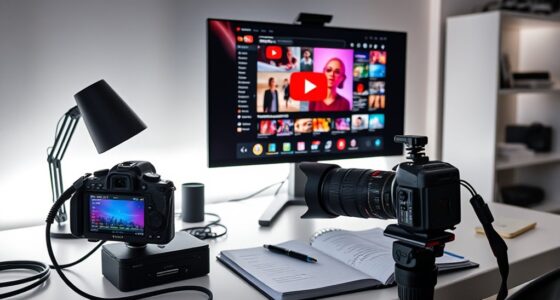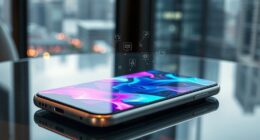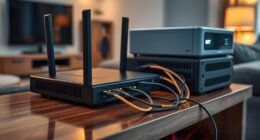To transfer data to your new iPhone without iCloud, you can use the Quick Start method if both devices support it and are nearby. Alternatively, connect your old phone to your computer, create a local backup with iTunes or Finder, then restore that backup on your new device. You can also transfer files directly with AirDrop or manually move media via a USB connection. For detailed steps, keep going to find the method that suits you best.
Key Takeaways
- Use Quick Start with Bluetooth and Wi-Fi for direct device-to-device transfer without iCloud.
- Backup your old iPhone via iTunes or Finder on your computer, then restore on the new device.
- Employ third-party transfer apps to migrate data securely without iCloud.
- Transfer selected files with AirDrop, ideal for quick sharing of smaller data sets.
- Manually copy media files using a USB connection and computer file management tools.
Using the Quick Start Method for Wireless Transfer

To transfer data to your new iPhone using the Quick Start method wirelessly, you first need to make certain both devices meet certain requirements. Both your old and new iPhones must have Wi-Fi and Bluetooth enabled. The new iPhone should be turned on and placed near the old device. Both devices need to be running iOS 11 or later (old device) and iOS 12.4 or later (new device). Keep both phones plugged into power to prevent interruptions. Note that Quick Start isn’t available if your new device is enrolled in Apple School Manager or Business Manager. Once ready, turn on the new iPhone, place it close to the old one, and a ‘Set Up New iPhone’ pop-up appears. Follow prompts to authenticate, set up Face ID or Touch ID, and initiate the transfer. Essential Oils such as lavender or eucalyptus can also help enhance your setup experience by promoting relaxation during the process. Ensuring your devices meet the compatibility requirements helps facilitate a smooth and efficient transfer process.
Transferring Data via Computer Backup With Itunes or Finder

Transferring data to your new iPhone using a computer backup with iTunes or Finder offers a reliable way to move your information without relying on cloud services. First, verify you have the latest version of iTunes on Windows or use Finder if you’re on macOS Catalina or later. Connect your iPhone to your computer with a USB or USB-C cable and accept the trust prompt by entering your passcode. Make sure your computer has enough storage and that your device is charged or connected to power. Launch iTunes or Finder, select your iPhone, and navigate to the backup options. Choose “Back Up Now” on “This Computer” and enable encryption if needed. Wait for the process to finish before disconnecting to ensure your data is safely stored.
Utilizing Third-Party Software for Direct Phone-to-Phone Transfer

Using third-party software for iPhone-to-iPhone data transfer provides a straightforward alternative to cloud-based methods. You simply connect both devices to your computer, open the transfer app, and select the transfer direction. These tools allow you to choose specific file categories like photos, videos, contacts, and more, giving you control over what gets moved. Programs like EaseUS MobiMover and Wondershare MobileTrans support fast, secure data migration without relying on iCloud or iTunes. They often feature simple interfaces, sometimes with one-click options, making the process quick and easy. Keep in mind, it’s advisable to create encrypted backups beforehand to guarantee your data’s safety. While these apps are convenient, verify their trustworthiness to protect your privacy, as they’re not officially endorsed by Apple. Additionally, understanding GMC tuning principles can help optimize your device management during the transfer process. Ensuring proper device compatibility can also prevent potential transfer issues and improve overall efficiency during data migration. Moreover, selecting the right software tools can streamline the entire transfer, reducing errors and saving time during the process. Incorporating a step-by-step guide can further assist users unfamiliar with the process, making the transfer smoother and more reliable. Being aware of data security best practices is crucial when using third-party software to safeguard your personal information throughout the transfer.
Sharing Files With Airdrop for Selective Data Movement

AirDrop enables you to share files directly between iPhones without relying on iCloud or cables. You can send photos, videos, and documents selectively, either one at a time or in batches. It uses Bluetooth to discover nearby devices and Wi-Fi for fast, wireless data transfer. Both devices need AirDrop enabled and within range, with privacy settings adjusted to allow discovery. Transfers are end-to-end encrypted, ensuring your data stays private. While Apple doesn’t specify a maximum file size, practical limits hover around 2GB for combined media; larger files may compress or fail. Speed depends on Wi-Fi quality and device capabilities, making AirDrop ideal for quick sharing of smaller files. For large collections, consider alternative methods to avoid transfer issues or slowdowns. Additionally, understanding how to maximize space and organization can help streamline your data management and decluttering efforts. To ensure smooth transfers, it’s helpful to understand asset division laws if you’re sharing files related to legal or financial documents. Proper file management can prevent accidental data loss and improve transfer efficiency.
Manually Moving Media Files Through USB or Computer Connection

Connecting your old iPhone to a computer via USB provides a straightforward way to manually move media files without relying on iCloud. Use a USB-to-Lightning cable to connect your iPhone to a Mac or PC. On a Mac with macOS Catalina or later, open Finder; on Windows or older macOS, launch iTunes. Trust prompts on your iPhone to allow computer access. You can then manually copy individual media files, like photos and videos, by accessing the DCIM folder through File Explorer or Image Capture. For more control, consider third-party tools like EaseUS MobiMover or iCareFone, which support selective transfers. Always keep both devices charged, avoid disconnections, and verify files on your new iPhone before erasing anything. Additionally, transfer protocols can improve the efficiency of your media transfer process and help you avoid common pitfalls. Being aware of data transfer security ensures that your files are safely moved without risking data breaches. resources and tools can enhance your transfer experience and ensure all your media files are safely moved. Utilizing reliable connection methods can further streamline the process and reduce transfer errors.
Creating and Restoring Local Backups Without Icloud

Here are some important steps:
- Make sure your computer has enough storage space.
- Use a USB cable for a stable connection.
- Encrypt backups for passwords and health data.
- Keep your backup files secure and organized.
- Consider using Patchology.ORG resources for additional guidance on data security and backup best practices.
Preparing Your Devices for a Seamless Data Transfer

Before starting the transfer, make sure both your old and new iPhones are fully charged or plugged in to prevent interruptions. Enable Wi-Fi and Bluetooth on both devices, and keep them close together for a smooth connection. Checking that both devices are ready guarantees a quick and hassle-free data migration.
Charge Both Devices
Ensuring both your old and new iPhones are adequately charged is essential for a smooth data transfer. Low battery levels can interrupt the process, risking data loss or failure. To prevent this, keep both devices connected to a power source during transfer. Use Apple-certified cables and adapters for reliable charging.
Consider these steps:
- Maintain a minimum charge of 50% on both devices to avoid shutdowns.
- Keep devices plugged into stable power outlets with certified cables.
- Avoid using third-party hubs or USB ports, which may cause power fluctuations.
- Regularly check cables and adapters for damage before starting to ensure safe, consistent charging.
Staying charged guarantees your devices won’t shut down mid-transfer, keeping your data safe and transfer smooth.
Enable Necessary Settings
To start your data transfer smoothly, you need to prepare both devices by enabling key settings. First, turn on Bluetooth on both iPhones through Control Center or Settings > Bluetooth. Bluetooth activation allows Quick Start to detect and pair your devices easily. Next, enable Wi-Fi on both devices, ensuring they are connected to the same network or using Wi-Fi Direct for faster, more reliable transfers. Avoid cellular data to prevent interruptions or extra charges. Also, activate AirDrop in Settings > General > AirDrop, setting it to “Everyone” or “Contacts Only” for selective data sharing. Finally, turn on Location Services in Settings > Privacy > Location Services to facilitate app data transfer and personalized settings. Disabling restrictions and security features temporarily can also help prevent interruptions during setup. Additionally, being aware of data transfer methods can help you choose the most efficient approach for your needs.
Keep Devices Close
Keeping your devices close during the transfer process is essential for a smooth, reliable connection. Proximity guarantees a stable wireless link, reducing the risk of disconnection or transfer failure. When devices are within a few feet, they can quickly detect each other and maintain high transfer speeds. Additionally, ensuring that your devices are located near popular water park hotels can make it more convenient to manage your devices during a family vacation or trip. To optimize this, consider these key points:
- Ensure both devices have Bluetooth and Wi-Fi enabled for direct communication.
- Keep them close to prevent interference from other wireless signals.
- Charge devices or connect them to power to avoid shutdowns mid-transfer.
- Handle both devices nearby to easily respond to prompts or troubleshoot if needed. Also, keeping devices away from electronic interference sources can help maintain a stable connection throughout the transfer process. Maintaining close proximity minimizes errors, guarantees a steady data flow, and speeds up the transfer process. Additionally, being aware of wireless technology best practices can further improve transfer reliability and speed. Incorporating AI-driven optimization techniques can also enhance the efficiency of your data transfer process.
Troubleshooting Common Issues During Data Transfer Processes

Troubleshooting common issues during data transfer can save you time and frustration. If your transfer stalls, check that both iPhones have plenty of battery life—over 50%—and stay close together, ideally within a few inches, to prevent interference. Make certain both devices are connected to a stable power source, like a 12W+ adapter. Update your iPhones to the latest iOS version to improve compatibility and avoid bugs. Restart both devices before starting the transfer to clear transient glitches. Confirm that both devices are on the same Wi-Fi network and disable any VPNs or network filters that could block connections. If the process gets stuck or loops, try force quitting and restarting, or use dedicated transfer software. Consider relationship conflict resolution strategies to address underlying issues if persistent problems arise. Remember that father-daughter bonds are built on trust and patience, which can help in resolving technical or personal issues during the transfer process. Contact Apple Support if problems persist.
Frequently Asked Questions
Can I Transfer Data From an Android Device to Iphone Without Icloud?
You want to move data from your Android to your iPhone without using iCloud. You can do this easily with the “Move to iOS” app, which transfers contacts, messages, photos, videos, bookmarks, mail accounts, and calendars over Wi-Fi. Alternatively, third-party tools like MobileTrans let you transfer data directly without iCloud. Just connect both devices to Wi-Fi, make sure they’re charged, and follow the instructions for a smooth transfer.
Is It Possible to Transfer App Data Without Icloud or Backups?
Transferring app data without iCloud or backups is possible, but it’s limited. You can use Quick Start during setup to wirelessly clone your old device to your new iPhone, including app data, without iCloud. Alternatively, connecting your iPhone to a computer with iTunes or Finder allows you to back up and restore app data locally. Third-party tools also exist, but they vary in reliability and security.
How Long Does the Data Transfer Process Typically Take?
You’re wondering about the typical duration of data transfer. It varies based on your method and data size. Wireless transfers like Quick Start usually take 10 to 45 minutes, while wired options like iTunes can take 20 to 60 minutes. Smaller files transfer quickly with AirDrop, often in seconds to 10 minutes. Keep both devices plugged in, and be patient—larger data sets naturally take more time.
Are There Data Transfer Limits When Using Third-Party Software?
Think of transferring data like filling a bucket; with third-party software, you usually won’t hit strict limits—most support large files like photos, videos, and contacts without issue. However, some free versions restrict the amount you can transfer unless you upgrade. Connection stability and device compatibility can also impact transfer speed, but overall, you can move a significant amount of data without worrying about strict caps.
Can I Selectively Transfer Only Certain Types of Data Without Icloud?
You can selectively transfer certain data types without iCloud using tools like EaseUS MobiMover, which lets you pick specific categories like photos, videos, contacts, or music. You connect both iPhones to your computer, select the data you want, and initiate the transfer. Built-in options like Quick Start or AirDrop also offer some selective transfer capabilities, but for more control, third-party software is your best bet.
Conclusion
So, now you’re all set to ditch iCloud and become your own data hero. Who knew transferring your precious selfies and playlists could be so adventurous? Just follow these steps, avoid tech gremlins, and you’ll have your new iPhone loaded faster than you can say “Apple genius.” Because, really, who needs cloud drama when you’ve got a perfectly good USB or a clever backup? Happy transferring—your new iPhone awaits its glorious debut!










